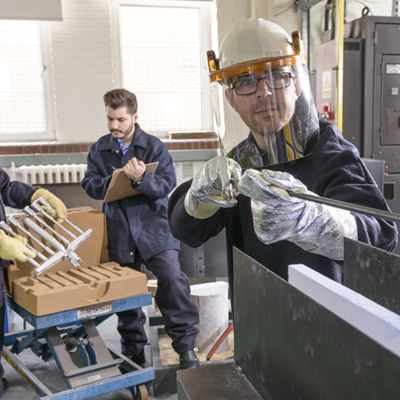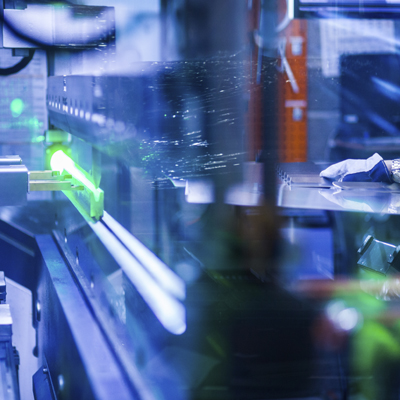Every year on the 22 April people around the world celebrate Earth Day. Established in 1970, Earth Day is a celebration of the modern environmental movement raising awareness of the many challenges which affect the environment and encouraging organisations and people of all ages to take action in protecting their environment. Today, people in over 192 countries take part in Earth Day in order to drive positive action for our planet.
Many governments across the globe now recognise the urgency to go further to tackle climate change and reduce greenhouse gas emissions, with many countries making a commitment to achieving net zero carbon emissions. With these vital, but ambitious, goals in mind it’s no surprise that there is an increasing interest in sustainable manufacturing from organisations and government bodies alike.
What is sustainable manufacturing?
According to the Sustainability Guide, sustainable manufacturing is the creation of products using processes which minimise negative environmental impacts, conserve energy and natural resources, and are safe for employees, communities and consumers.
Sustainable manufacturers consider the whole product lifecycle so that not only is the product sustainable but so too are the manufacturing processes used to create it. They aim to conserve energy and natural resources, as well as improving the manufacturing, repairability and disassembly of their product - in turn increasing the company’s contribution to social and environmental benefits.
Manufacturing needs to be transformed to ensure its long-term viability
Professor Konstantinos Salonitis, Head of the Sustainable Manufacturing Systems Centre, says: “We need transformational change. A growing number of manufacturers of all sizes now realise that there are substantial environmental and financial benefits from implementing sustainable manufacturing practices. These organisations have sustainability as an important objective in their strategies, for example, increasing operational efficiency by reducing waste and costs, and thereby they are building long-term success and business viability.”
There are many reasons for implementing sustainable manufacturing practices – not only can it be very cost-effective, but it can also enhance the safety of the facility, the employees, the products and the community. It can also improve the reputation of the brand, which can have a positive impact on sales and instill customer trust. These days, many purchasers and consumers actively seek out suppliers who have eco-friendly processes – we all want to feel good about what we are purchasing.
With this in mind researchers from the Sustainable Manufacturing Systems Centre (SMSC) at Cranfield University are working to create new models of best practice to help businesses think green, smart, and (c)lean. Their areas of research include:
- Developing manufacturing processes and systems.
- Eco-factories based on the circular economy.
- Road maps for the factories of the future as they transition to net zero.
- New materials for sustainable and smart growth.
- Integration of smart technologies for sustainability in manufacturing.
The Centre is working on a number of exciting research projects in this area:
Small is beautiful in bid for cost and energy savings
The ‘Small is Beautiful’ project, funded by the Engineering and Physical Sciences Research Council (EPSRC), focuses on reducing the amount of energy used in manufacturing processes.
The UK is at the forefront of light metal casting and investment casting technologies which are vital to the global aerospace and automotive industries. There are some 400 foundries based in the UK; with around half of the European investment casting foundries located in the UK. However, we currently use the energy equivalent of every man, woman and child boiling a kettle twice a day, every day of the year, just to melt the aluminium for casting in the UK.
Small is Beautiful looks at how to make light metals casting more energy and material efficient. A new technique called Constrained Rapid Induction Melting Single Shot Up-Casting (CRIMSON) has been introduced which could reduce the energy costs of light metal/aluminium foundries by at least 50%. This enables foundries to heat only the amount of material needed to fill a single mould - rather than the current approach which is to melt whole batches of metal.
CRIMSON (which relies on a counter-gravity casting method) minimises the oxidation of liquid metal which develops during the traditional method’s pouring process, leading to higher yields than found in traditional techniques. The castings produced are of a higher quality than under previous techniques, leading to a reduced scrap rate and lower remelting costs.
The ‘Small is Beautiful’ project is developing a software tool that incorporates a new philosophy/methodology and metric for the handling of materials and energy throughout the process in foundries, using a computer numerical process simulation to support the decision-making. It will also look at the full energy chain - from charge materials through to waste heat and energy in the process - and identify the opportunities for scavenging waste heat and reducing the costs associated with the whole process. By doing so, it will enable cost-benefit analysis to be undertaken so that companies will be able to make informed decisions about design, material and process at a very early stage of manufacturing.
‘Cradle-to-grave’ approach is needed for the full picture
Another project Cranfield researchers are working on relates to embodied carbon, or carbon embodiment. Embodied carbon is the carbon footprint of a material - all the CO2 emitted in producing a material or product – and it considers how many greenhouse gases (GHGs) are released throughout the supply chain.
“Too much of the focus on the evolution to green technologies is on the ‘use’ phase of products,” says Mark Jolly, Director of Manufacturing and Professor of Sustainable Manufacturing. “It’s been all about whether those products are low energy; their ability to be recycled. To be responsible consumers, we have to be looking at the full picture in terms of materials used and the environmental cost of manufacture. Because the reality is that by the time the recycling stage has been reached, the heavy energy use and carbon footprint has already been made; scarce materials have been wasted.”
With regards to carbon embodiment, most lifecycle assessment studies are non-proportionally focused on the use phase of a product without considering, at least to the required depth, the manufacturing phase. Although, most of these studies claim a ‘cradle-to-grave’ approach, the early phases of material extraction, processing and eventually manufacturing of the component, are not discussed and analysed with the proper rigor. Such deficiencies in the analysis can mislead, and do not allow for a full understanding of the whole picture, or how best to employ strategies to reduce carbon embodiment. These strategies could include:
- Using local products made from locally available raw materials.
- Using manufacturers close to use sites, especially in the construction industry.
- Transporting materials and products in low carbon vehicles.
- Using systems and materials that have long life spans.
The ‘Carbon embodiment in manufacturing’ research project, sponsored by High Value Manufacturing Catapult, will focus on the manufacturing phase of two specific components from the aerospace and the automotive sector and adopt a ‘cradle-to-grave’ approach that includes the energy consumption that occurs due to resource extraction and processing, component and product assembly, use, and end-of-life processing of such a component.
A detailed ‘cradle-to-grave’ study by the SMSC of the total energy and CO2 impact of passenger vehicle engine production has demonstrated how the manufacture of more lightweight ‘green’ vehicles with aluminium engines actually means the use of up to four times more energy. A typical aluminium car would need to be driven for between 185,000 km and 560,000 km before there were environmental benefits from lower fuel use. The waste from the production of aluminium, what’s known as ‘red mud’ is highly toxic.
Manufacturers aren’t in charge of all the materials they use - but they do need to be look back to the full extent of the supply chain, unpicking the provenance of what is actually going into products. With the growing scarcity of natural resources, there needs to be more attention to alternatives: organic materials, that can be grown, and in themselves have carbon-reducing effects.
Learn more…
- Find out more about sustainable manufacturing at Cranfield.
- Check out our recent ‘Sustainability in business’ webinar on demand.
- Revisit our key takeaways from the National Manufacturing Debate 2020 – which focused on decarbonisation in the industry.
- Read about decarbonising the manufacturing industry.


